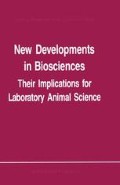Abstract
The question whether animals experience pain has found different answers. The question cannot be answered in as far as it deals with the aspect of subjective experience; this is unaccessible to empirical investigation, for fundamental reasons. Most scientists, however, will accept a ‘postulate of homology’: because sensory and neural processes and structures are organised in essentially similar ways, at least in mammals, they feel bound to assume that these animals know experiences that are homologous to ours, also with respect to the sensation of pain (20). A more modest approach is to investigate the behavioural responses to damaging influences.
Access this chapter
Tax calculation will be finalised at checkout
Purchases are for personal use only
Preview
Unable to display preview. Download preview PDF.
References
Baerends GP: The functional organization of behaviour. Anim. Behav. 27, 726–38, 1979.
Berkson G: The social ecology of defects in primates. In Primate biosocial development. New York, Garland, 189–204, 1977.
Blanchard DC & Blanchard RJ: PDR theory — a psychological approach to biological questions. Behav. Brain Sci. 3, 302–3, 1980.
Bolles RC & Fanselow MS: Perceptual-defensive-recuperative model of fear and pain. Behav. Brain Sci. 3, 291–323, 1980.
Bond MR: Pain, its Nature, Analysis and Treatment. Edinburgh: Churchill Livingstone, 1979.
Bowsher D: Dual mechanism of pain. Behav. Brain Sci. 3, 303–4, 1980.
Brown, JL: The evolution of behavior. New York: Norton, 1975.
Fedigan LM & Fedigan L.: The social development of a handicapped infant in a free-living troop of Japanese monkeys. In Primate Bio-social Development (S Chevalier-Skolnikoff e.a.,eds) Garland, New York,205–22,1977.
Fordyce WE: Learning, processes in pain. In The Psychology of Pain (RA Sternbach, ed). New York: Raven, 49–72, 1978.
Grauvogel A: Zum Begriff des Leidens. Der prakt. Tierarzt 1, 36–44, 1983.
Hamilton WD: The genetic evolution of social behaviour. J. theor. Biol. 7, 1–52, 1964.
Hart B.: Canine Behavior. Santa Barbara: Vet. Practice Publ., 1980.
Hooff JARAM van: Pijn, gewaarwording en expressie: een ethologische beschouwing. Tijdschr. Diergeneesk. 110, 59–68, 1985.
Lawick-Goodall H van & Lawick-Goodall J van: Innocent Killers. London and Glasgow: Collins Clear-Type Press, 1976.
Melzack R & Wall PD: Pain mechanisms: a new theory. Science 150, 971–9, 1965.
Menges LJ: De psychologie van de patient met pijn. In Pijn bij Mens en Dier (P van Duijn et al., eds). Wageningen: Pudoc, 79–80, 1980.
Mickwitz G von: Schmerz und Schmerzreaktionen beim Tier. Der prakt. Tierarzt 1, 26–36, 1983.
Mowrer OH: On the dual nature of learning: a reinterpretation of conditioning and problem-solving. Harvard Educ. Rev. 17, 102–47, 1947.
Pilowsky I: Psychodynamic aspects of the pain experience. In The Psychology of Pain (RA Sternbach, ed.). New York: Raven, 203–18, 1978.
Putten G van: Pijn bij dieren. In Pijn bij Mens en Dier (P. van Duijn et al., eds). Wageningen: Pudoc, 12–25, 1980.
Salzen EA: The ontogeny of fear in animals. In Fear in Animals and Man. New York: Van Nostrand Reinhold, 125–63, 1979.
Siebenaler JB & Caldwell DK: Cooperation among adult dolphins. J. Mammol. 37, 126–8, 1956.
Sternbach RA: The Psychology of Pain. New York: Raven, 1978.
Sternbach RA: Psychogenic pain. Schmerz 2, 17–23, 1981.
Thierry B, Steru L, Chermat R & Simon T: Searching-waiting strategy: a candidate for an evolutionary model of depression. Behav. Neur. Biol. 1984.
Verheijen FJ: Pijn en angst bij een aan de haak geslagen vis. Biotechn. 25, 77–81, 1986.
Wemelsfelder F: Gedrag als mogelijke indicator voor pijn bij biggen. Zeist: IVO’ schoonoord’, 1982.
Editor information
Editors and Affiliations
Rights and permissions
Copyright information
© 1988 Martinus Nijhoff Publishers, Dordrecht
About this chapter
Cite this chapter
Van Hooff, J.A.R.A.M. (1988). On the Ethology of Pain, its Experience and Expression. In: Beynen, A.C., Solleveld, H.A. (eds) New Developments in Biosciences: Their Implications for Laboratory Animal Science. Springer, Dordrecht. https://doi.org/10.1007/978-94-009-3281-4_8
Download citation
DOI: https://doi.org/10.1007/978-94-009-3281-4_8
Publisher Name: Springer, Dordrecht
Print ISBN: 978-94-010-7973-0
Online ISBN: 978-94-009-3281-4
eBook Packages: Springer Book Archive

